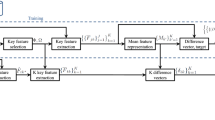Abstract
One of the principal challenges in developing robust Machine Learning (ML) classification algorithms for Human Activity Recognition (HAR) from real-time smart home sensor data is how to account for variations in 1) the activity sequence length, 2) the contribution each sensor has to an activity, and 3) the amount of activity class imbalance. Such changes generate observations that do not conform to expected patterns potentially reducing the efficacy of classification models. Moreover the architecture of prior solutions have been quite complex which have resulted in large training times for these approaches to achieve acceptable classification accuracy. In this paper we address these three issues by 1) proposing a data structure representing the duration and frequency information of each sensor for an activity, 2) transforming this data structure into an Information Retrieval (IR)-based representation, and finally 3) compare and contrast the utility of this IR-based representation using four different supervised classifiers. Our proposed framework in combination with a state-of-the-art ensemble learner results in more accurate and scalable ML classification models that are better suited toward off-line HAR in a smart home setting.
Access this chapter
Tax calculation will be finalised at checkout
Purchases are for personal use only
Similar content being viewed by others
Notes
- 1.
http://hyperopt.github.io/hyperopt/. Last accessed 30th September, 2020.
References
Abidine, M.B., Fergani, L., Fergani, B., Fleury, A.: Improving human activity recognition in smart homes. Int. J. E-Health Med. Commun. 6(3), 19–37 (2015). https://doi.org/10.4018/IJEHMC.2015070102
Amiribesheli, M., Benmansour, A., Bouchachia, A.: A review of smart homes in healthcare. J. Amb. Intell. Hum. Comput. 6(4), 495–517 (2015). https://doi.org/10.1007/s12652-015-0270-2
Bouchachia, A., Vanret, C.: GT2FC: an online growing interval type-2 self-learning fuzzy classifier. IEEE Trans. Fuzzy Syst. 22(4), 999–1018 (2014)
Chen, L., Nugent, C.D., Wang, H.: A knowledge-driven approach to activity recognition in smart homes. IEEE Trans. Knowl. Data Eng. 24(6), 961–974 (2012)
Chen, T., Guestrin, C.: XGBoost: a scalable tree boosting system. In: Proceedings of 22nd ACM SIGKDD International Conference on Knowledge Discovery and Data Mining, KDD 2016, pp. 785–794. ACM, New York (2016)
Cook, D.J.: Learning setting-generalized activity models for smart spaces. IEEE Intel. Syst. 27(1), 32–38 (2012)
Cook, D.J., Schmitter-Edgecombe, M.: Assessing the quality of activities in a smart environment. Method Inf. Med. 48(5), 480–485 (2009)
Cortes, C., Vapnik, V.: Support-vector networks. Mach. Learn. 20(3), 273–297 (1995)
Dietterich, T.G.: An experimental comparison of three methods for constructing ensembles of decision trees: bagging, boosting, and randomization. Mach. Learn. 40(2), 139–157 (2000)
Duarte, J., Gama, J., Bifet, A.: Adaptive model rules from high-speed data streams. ACM Trans. Knowl. Discov. Data 10(3), 30:1–30:22 (2016)
Gama, J., Žliobaitė, I., Bifet, A., Pechenizkiy, M., Bouchachia, A.: A survey on concept drift adaptation. ACM Comput. Surv. 46(4), 44:1–44:37 (2014)
Gu, T., Wu, Z., Tao, X., Pung, H.K., Lu, J.: epSICAR: an emerging patterns based approach to sequential, interleaved and concurrent activity recognition. In: Proceedings of 7th IEEE International Conference on Pervasive Computing and Communications, pp. 1–9. IEEE (2009)
Guo, J., Mu, Y., Xiong, M., Liu, Y., Gu, J.: Activity feature solving based on TF-IDF for activity recognition in smart homes. Complexity 37, 1–10 (2019)
Hoque, E., Dickerson, R.F., Preum, S.M., Hanson, M., Barth, A., Stankovic, J.A.: Holmes: a comprehensive anomaly detection system for daily in-home activities. In: 2015 International Conference on Distributed Computing in Sensor Systems, pp. 40–51. IEEE Press, June 2015
Jurek, A., Nugent, C., Bi, Y., Wu, S.: Clustering-Based Ensemble Learning for Activity Recognition in Smart Homes. Sensors 14, 12285–12304 (2014)
Kim, E., Helal, S., Cook, D.: Human activity recognition and pattern discovery. IEEE Perv. Comput. 9(1), 48–53 (2010)
Kim, E., Helal, S., Nugent, C., Beattie, M.: Analyzing activity recognition uncertainties in smart home environments. ACM Trans. Intell. Syst. Technol. 6(4), 52:1–52:28 (2015). https://doi.org/10.1145/2651445
Kondylidis, N., Tzelepi, M., Tefas, A.: Exploiting TF-IDF in deep convolutional neural networks for content based image retrieval. Multimed. Tools Appl. 77(23), 30729–30748 (2018)
Krishnan, N.C., Cook, D.J.: Activity recognition on streaming sensor data. Perv. Mob. Comput. 10(Part B), 138–154 (2014)
Lühr, S., Lazarescu, M.: Incremental clustering of dynamic data streams using connectivity-based representative points. IEEE Trans. Knowl. Data Eng. 68, 1–27 (2009)
Okeyo, G., Chen, L., Wang, H., Sterritt, R.: Dynamic sensor data segmentation for real-time knowledge-driven activity recognition. Perv. Mob. Comput. 10(Part B), 155–172 (2014)
Sagha, H., Bayati, H., Millán, J.D.R., Chavarriaga, R.: On-line anomaly detection and resilience in classifier ensembles. Patt. Recogn. Lett. 34(15), 1916–1927 (2013)
Silva, J.A., Faria, E.R., Barros, R.C., Hruschka, E.R., Carvalho, A.C.D., Gama, J.: Data stream clustering: a survey. ACM Comput. Surv. 46(1), 13:1–13:31 (2013)
Van Kasteren, T., Noulas, A., Englebienne, G., Kröse, B.: Accurate activity recognition in a home setting. In: Proceedings of 10th International Conference on Ubiquitous Computing, pp. 1–9. ACM (2008)
Wen, J., Zhong, M.: Activity discovering and modelling with labelled and unlabelled data in smart environments. Expert Syst. Appl. 42(14), 5800–5810 (2015)
Wu, X., et al.: Top 10 algorithms in data mining. Knowl. Inf. Syst. 14(1), 1–37 (2007)
Zhu, C., Sheng, W., Liu, M.: Wearable sensor-based behavioral anomaly detection in smart assisted living systems. IEEE Trans. Autom. Sci. Eng. 12(4), 1225–1234 (2015)
Author information
Authors and Affiliations
Corresponding author
Editor information
Editors and Affiliations
Rights and permissions
Copyright information
© 2021 Springer Nature Switzerland AG
About this paper
Cite this paper
Woodford, B.J., Ghandour, A. (2021). An Information Retrieval-Based Approach to Activity Recognition in Smart Homes. In: Hacid, H., et al. Service-Oriented Computing – ICSOC 2020 Workshops. ICSOC 2020. Lecture Notes in Computer Science(), vol 12632. Springer, Cham. https://doi.org/10.1007/978-3-030-76352-7_51
Download citation
DOI: https://doi.org/10.1007/978-3-030-76352-7_51
Published:
Publisher Name: Springer, Cham
Print ISBN: 978-3-030-76351-0
Online ISBN: 978-3-030-76352-7
eBook Packages: Computer ScienceComputer Science (R0)




